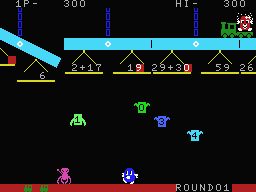Retro Replay Review
Gameplay
Balance delivers a straightforward yet compelling gameplay loop centered around solving mathematical equations under pressure. Players are presented with an unbalanced lever where one arm displays an equation missing a single number, and the opposite arm shows the target result. Your task is to identify the missing value and drag it into place before the lever tips out of balance. This mechanic is both intuitive and engaging, combining basic arithmetic skills with real-time decision-making.
The game’s time constraint adds an extra layer of excitement: a truck icon moves across the top of the screen from right to left, signaling how much time remains to solve each puzzle. If the lever isn’t balanced in time, the truck topples off the edge, costing you a life. This visual countdown keeps players constantly aware of the ticking clock, transforming what could be a simple drill into a fast-paced challenge that tests both accuracy and speed.
As you progress, the complexity of equations increases, introducing multi-step problems and larger numbers to keep seasoned players on their toes. Lives are limited, so every misstep or slow reaction carries weight. The balance between difficulty and reward is well-tuned, ensuring that newcomers can build confidence in early levels while more experienced users find enough challenge to remain engaged.
Graphics
Balance sports a clean, minimalist art style that prioritizes clarity over flashy visuals—perfectly suited to its educational goals. The lever mechanism is clearly rendered with bright colors that make the equations and numbers pop against a neutral background. This simplicity ensures there’s no visual clutter, allowing players to focus on problem-solving without unnecessary distractions.
Animation is smooth and purposeful: when a correct solution is placed, the lever gently swings into alignment and emits a satisfying chime. Conversely, an incorrect answer triggers a brief shake and a subtle red flash, instantly signaling the mistake. The truck animation is both charming and functional, reinforcing the urgency of the timer mechanic without feeling gimmicky.
While the game doesn’t aim for photorealism or high-end graphical effects, its polished 2D interface and cheerful color palette create an inviting atmosphere for learners of all ages. Menu transitions are animated just enough to feel modern, yet they remain snappy and responsive, ensuring that the pacing of learning and play never drags.
Story
Balance does not follow a traditional narrative structure; instead, it weaves a loose thematic premise around the concept of equilibrium and problem-solving. The simple setting of laboratory-style scales and a trusty delivery truck offers just enough context to keep players invested in the “why” behind each puzzle. While there are no characters or cinematic sequences, the game’s theme subtly reinforces the importance of balance in both mathematical equations and real-world scenarios.
Some players may miss a deeper storyline or character-driven motivation, but the lack of narrative does not detract from the core educational objectives. In fact, the streamlined premise ensures that attention remains squarely on mastering arithmetic skills rather than following a convoluted plot. For educators and parents seeking a focused learning tool, this approach feels appropriate and effective.
Progression is marked by unlocking new sets of equations and watching the difficulty ramp up, which serves as a form of implicit narrative—your growing competence in balancing increasingly complex problems. Though there’s no cutscene celebrating your victories, the steady introduction of challenges provides a sense of growth and accomplishment that mirrors a more traditional story arc.
Overall Experience
Balance stands out as an educational title that skillfully marries gameplay mechanics with learning objectives. It offers a refreshing alternative to rote memorization by turning arithmetic drills into an interactive test of both brain and reflexes. Whether you’re a student looking to sharpen basic math skills or an adult seeking a quick cognitive workout, Balance caters to a wide audience.
The game’s pacing feels just right: early levels build confidence with simple equations, while later stages demand quicker thinking and more advanced calculations. The life-based penalty for mistakes and the ticking truck timer introduce stakes without causing frustration—most players will find themselves returning to try “just one more level” to improve both score and speed.
With its user-friendly interface, adaptable difficulty curve, and clean visual design, Balance is a strong recommendation for anyone interested in edutainment. It succeeds in making math practice enjoyable and engaging, proving that learning games do not need to sacrifice entertainment value to be educationally valuable. Balance strikes exactly the right equilibrium between fun and function.
 Retro Replay Retro Replay gaming reviews, news, emulation, geek stuff and more!
Retro Replay Retro Replay gaming reviews, news, emulation, geek stuff and more!








Reviews
There are no reviews yet.